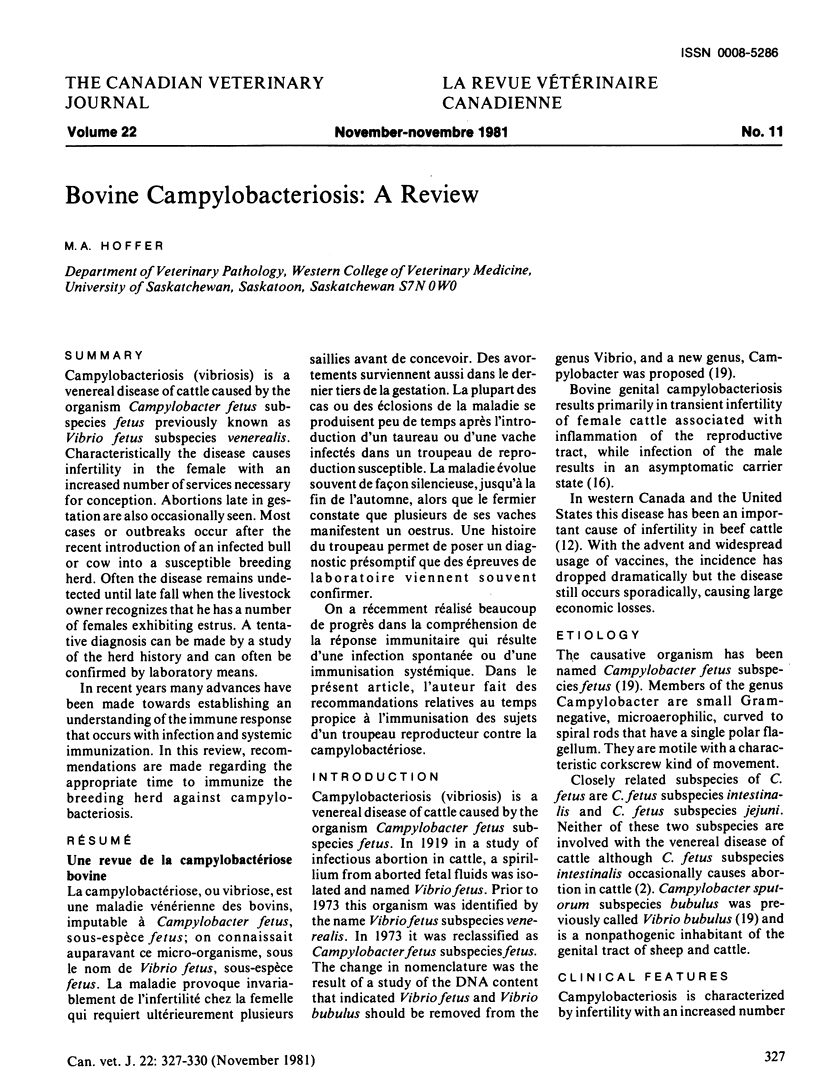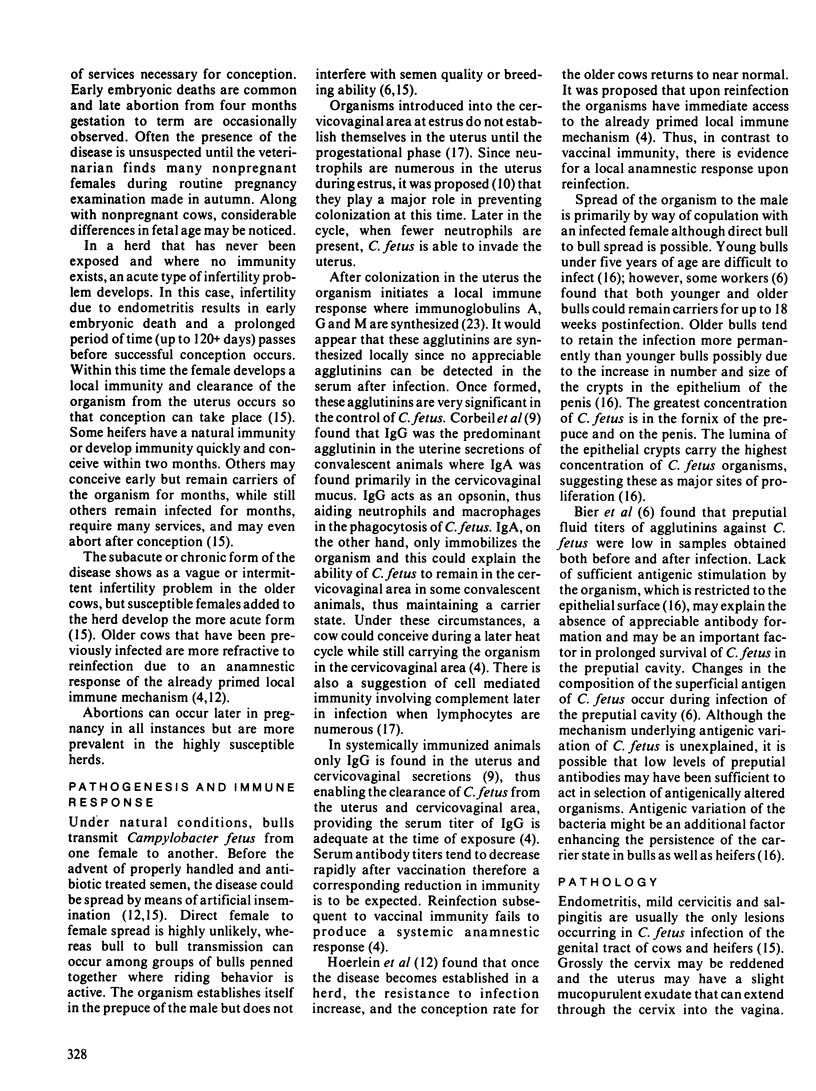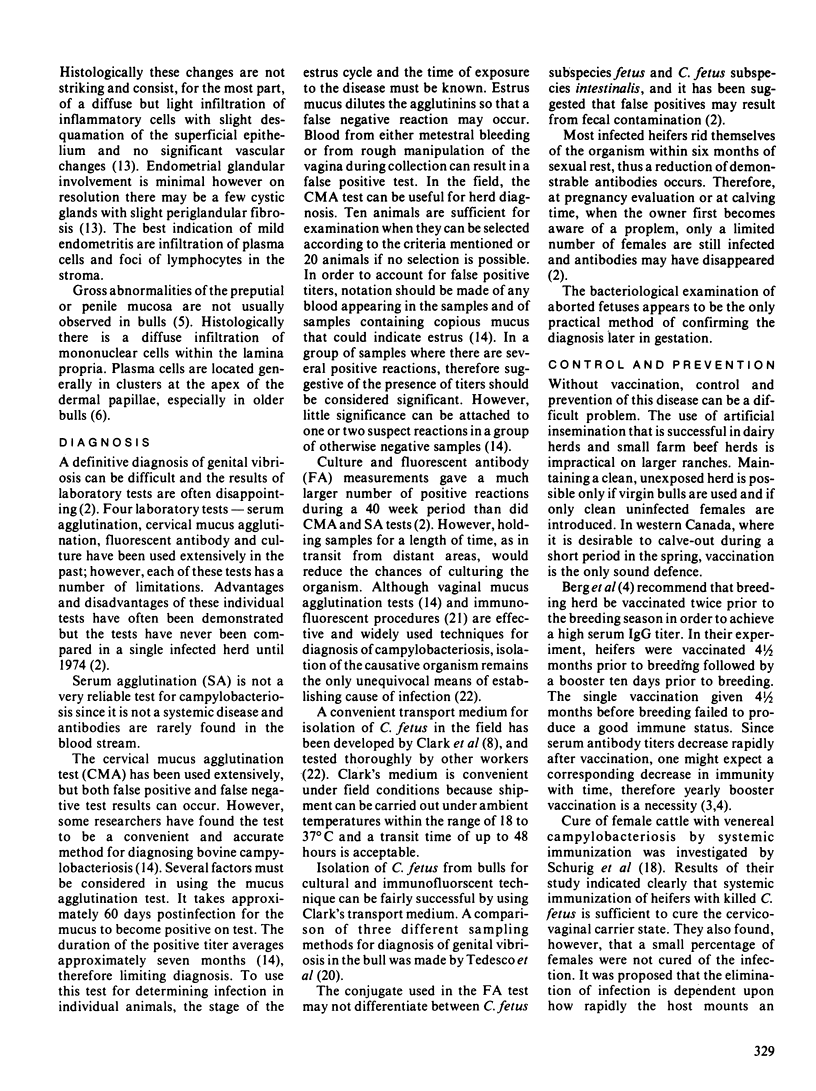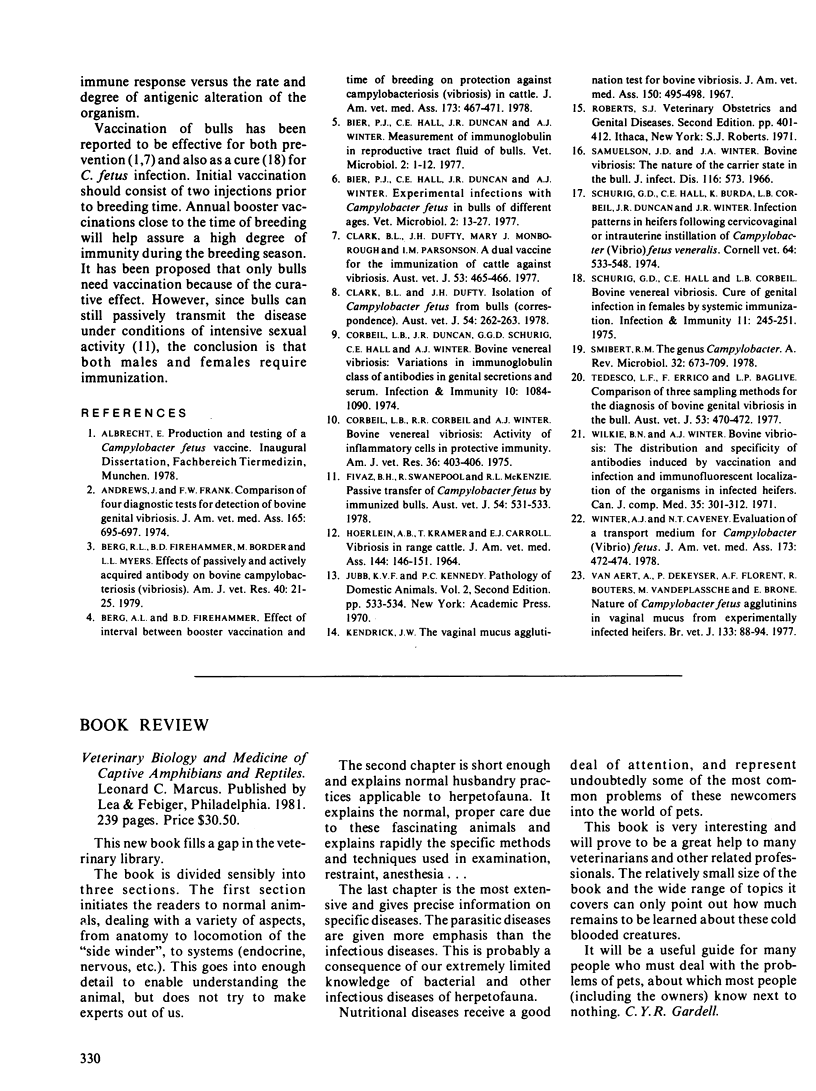Abstract
Campylobacteriosis (vibriosis) is a venereal disease of cattle caused by the organism Campylobacter fetus subspecies fetus previously known as Vibrio fetus subspecies venerealis. Characteristically the disease causes infertility in the female with an increased number of services necessary for conception. Abortions late in gestation are also occasionally seen. Most cases or outbreaks occur after the recent introduction of an infected bull or cow into a susceptible breeding herd. Often the disease remains undetected until late fall when the livestock owner recognizes that he has a number of females exhibiting estrus. A tentative diagnosis can be made by a study of the herd history and can often be confirmed by laboratory means.
In recent years many advances have been made towards establishing an understanding of the immune response that occurs with infection and systemic immunization. In this review, recommendations are made regarding the appropriate time to immunize the breeding herd against campylobacteriosis.
Full text
PDF



Selected References
These references are in PubMed. This may not be the complete list of references from this article.
- Andrews P. J., Frank F. W. Comparison of four diagnostic tests for detection of bovine genital vibriosis. J Am Vet Med Assoc. 1974 Oct 15;165(8):695–697. [PubMed] [Google Scholar]
- Berg R. L., Firehammer B. D., Border M., Myers L. L. Effects of passively and actively acquired antibody on bovine campylobacteriosis (vibriosis). Am J Vet Res. 1979 Jan;40(1):21–25. [PubMed] [Google Scholar]
- Berg R. L., Firehammer B. D. Effect of interval between booster vaccination and time of breeding on protection against campylobacteriosis (vibriosis) in cattle. J Am Vet Med Assoc. 1978 Sep 1;173(5 Pt 1):467–471. [PubMed] [Google Scholar]
- Clark B. L., Dufty J. H. Isolation of Campylobacter fetus from bulls. Aust Vet J. 1978 May;54(5):262–263. [PubMed] [Google Scholar]
- Clark B. L., Dufty J. H., Monsbourgh M. J., Parsonson I. M. A dual vaccine for the immunisation of cattle against vibriosis. Aust Vet J. 1977 Oct;53(10):465–466. doi: 10.1111/j.1751-0813.1977.tb05460.x. [DOI] [PubMed] [Google Scholar]
- Corbeil L. B., Corbeil R. R., Winter A. J. Bovine venereal vibriosis: activity of inflammatory cells in protective immunity. Am J Vet Res. 1975 Apr;36(4 PT1):403–406. [PubMed] [Google Scholar]
- Corbeil L. B., Duncan J. R., Schurig G. G., Hall C. E., Winter A. J. Bovine venereal vibriosis: variations in immunoglobulin class of antibodies in genital secretions and serum. Infect Immun. 1974 Nov;10(5):1084–1090. doi: 10.1128/iai.10.5.1084-1090.1974. [DOI] [PMC free article] [PubMed] [Google Scholar]
- Fivaz B. H., Swanepoel R., McKenzie R. L., Wilson A. Passive transmission of Campylobacter fetus by immunised bulls. Aust Vet J. 1978 Nov;54(11):531–533. doi: 10.1111/j.1751-0813.1978.tb00325.x. [DOI] [PubMed] [Google Scholar]
- HOERLEIN A. B., KRAMER T., CARROLL E. J., BROWN W. W., Jr, SCOTT J. A., BALL L. VIRBRIOSIS IN RANGE CATTLE. J Am Vet Med Assoc. 1964 Jan 15;144:146–151. [PubMed] [Google Scholar]
- Kendrick J. W. The vaginal mucus agglutination test for bovine vibriosis. J Am Vet Med Assoc. 1967 Mar 1;150(5):495–498. [PubMed] [Google Scholar]
- Schurig G. D., Hall C. E., Burda K., Corbeil L. B., Duncan J. R., Winter A. J. Infection patterns in heifers following cervicovaginal or intrauterine instillation of Campylobacter (Vibrio) fetus venerealis. Cornell Vet. 1974 Oct;64(4):533–548. [PubMed] [Google Scholar]
- Schurig G. G., Hall C. E., Corbell L. B., Duncan J. R., Winter A. J. Bovine veneral vibriosis: cure of genital infection in females by systemic immunization. Infect Immun. 1975 Feb;11(2):245–251. doi: 10.1128/iai.11.2.245-251.1975. [DOI] [PMC free article] [PubMed] [Google Scholar]
- Smibert R. M. The genus Campylobacter. Annu Rev Microbiol. 1978;32:673–709. doi: 10.1146/annurev.mi.32.100178.003325. [DOI] [PubMed] [Google Scholar]
- Tedesco L. F., Errico F., Del Baglivi L. P. Comparison of three sampling methods for the diagnosis of genital vibriosis in the bull. Aust Vet J. 1977 Oct;53(10):470–472. doi: 10.1111/j.1751-0813.1977.tb05463.x. [DOI] [PubMed] [Google Scholar]
- Van Aert A., De Keyser P., Florent A. F., Bouters R., Vandeplassche M., Brone E. Nature of Campylobacter fetus agglutinins in vaginal mucus from experimentally infected heifers. Br Vet J. 1977 Jan-Feb;133(1):88–94. doi: 10.1016/s0007-1935(17)34192-1. [DOI] [PubMed] [Google Scholar]
- Vogel R. A. The indirect fluorescent antibody test for the detection of antibody in human cryptococcal disease. J Infect Dis. 1966 Dec;116(5):573–580. doi: 10.1093/infdis/116.5.573. [DOI] [PubMed] [Google Scholar]
- Wilkie B. N., Winter A. J. Bovine vibriosis: the distribution and specificity of antibodies induced by vaccination and infection and the immunofluorescent localization of the organism in infected heifers. Can J Comp Med. 1971 Oct;35(4):301–312. [PMC free article] [PubMed] [Google Scholar]
- Winter A. J., Caveney N. T. Evaluation of a transport medium for campylobacter (Vibrio) fetus. J Am Vet Med Assoc. 1978 Sep 1;173(5 Pt 1):472–474. [PubMed] [Google Scholar]


